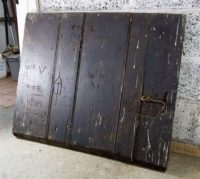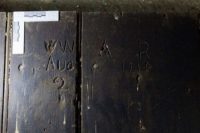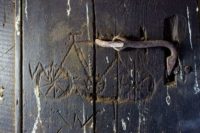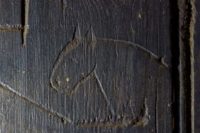 An old stable door carved with graffiti marking the day World War I began has been discovered near Quadring in Lincolnshire. Archaeologist Neville Hall was recording historic architecture in the Fens for a barn conversion when he came across the poignant record of life from the Lost Generation at the cusp of their agonizing losses.
An old stable door carved with graffiti marking the day World War I began has been discovered near Quadring in Lincolnshire. Archaeologist Neville Hall was recording historic architecture in the Fens for a barn conversion when he came across the poignant record of life from the Lost Generation at the cusp of their agonizing losses.
Carved deep into the wood is W W A R/ AUG 2 1914. (The article says Aug 4th, the day Britain declared war on Germany, but unless my eyes deceive me,  that’s definitely a two in the photograph.) On August 2nd, German forces crossed into Luxembourg and gave Belgium an ultimatum: let the German army invade “protect” it from a French invasion. Belgian neutrality had been agreed to by Britain, Germany and France in the aftermath of the Franco-Prussian War and Britain had pledged itself to declare war on anyone who violated the principle of Belgian neutrality.
that’s definitely a two in the photograph.) On August 2nd, German forces crossed into Luxembourg and gave Belgium an ultimatum: let the German army invade “protect” it from a French invasion. Belgian neutrality had been agreed to by Britain, Germany and France in the aftermath of the Franco-Prussian War and Britain had pledged itself to declare war on anyone who violated the principle of Belgian neutrality.
August 2nd was also the day the war, technically not yet begun, claimed its first two casualties, one French, one German. Lieutenant Albert Mayer, was on a reconnaissance mission just over the border in France; Corporal Jules-André Peugeot commanded the patrol group who caught him. An exchange of fire killed Mayer instantly; Peugeot died of his wounds later that morning.
 It makes sense that the two youths who carved their initials in the door would see August 2nd as the war having begun before hostilities were formally opened in a declaration of war two days later. It’s also evidence that the graffito was carved on the actual day as it happened rather than having been added in hindsight.
It makes sense that the two youths who carved their initials in the door would see August 2nd as the war having begun before hostilities were formally opened in a declaration of war two days later. It’s also evidence that the graffito was carved on the actual day as it happened rather than having been added in hindsight.
The two young men have been identified, thanks to those initials. They were neighbors and must have been playmates as kids, carving drawings of a horse, a classic child’s version of a house — a square topped by a triangle — that may have been a barn or stable as the horse is tethered to it, a bicycle, two ploughs as well as their initials.
“With help from the farm’s previous owner, we have been able identify the children who created the graffiti – William Bristow and John Leusley – and trace the poignant story of their families during the war,” said Ian Marshman, historic environment officer at Lincolnshire County Council.
William was the youngest son of the family who then owned the farm, whilst John Leusley was the eldest son of the landlord of the pub next door. Both boys survived the war, but not unscathed.
It is believed that William stayed to help his widowed mother and elder brother Fred on the farm, producing vital food supplies exempting him from conscription. Meanwhile, John served with the Cheshire Regiment and was injured in France.
John served as a private, deploying after 1915. His records indicate he was entitled to the Victory Medal (awarded to all who left their native countries to serve abroad) and the British War Medal (awarded to all who entered a theater of war).
 While he and his old friend came home alive, John’s brother, Private Richard Leusley, was reported killed in action on the Western Front on January 1st, 1918. The winter of 1917-1918 saw a lot of brutally futile action due to the French and British governments and commands insistence on extending the 100 miles of French front held by British forces. They wanted to push it 40 miles deeper into German territory, Richard’s body was never recovered. He is listed among the missing on the British Tyne Cot Memorial to the Missing outside Passchendale, Belgium. Thankfully the youngest Leusley brother, William, survived his war.
While he and his old friend came home alive, John’s brother, Private Richard Leusley, was reported killed in action on the Western Front on January 1st, 1918. The winter of 1917-1918 saw a lot of brutally futile action due to the French and British governments and commands insistence on extending the 100 miles of French front held by British forces. They wanted to push it 40 miles deeper into German territory, Richard’s body was never recovered. He is listed among the missing on the British Tyne Cot Memorial to the Missing outside Passchendale, Belgium. Thankfully the youngest Leusley brother, William, survived his war.
Ian added: “For us, this is an amazing discovery and a real reminder of what Lincolnshire childhoods – of horses, bicycles and making your own fun – on the eve of war.
“The door will be preserved by the descendants of the Bristow family, but the research on the farm and graffiti will be added to the county council’s Historic Environment Record, where it will be available to future researchers.”
Some events just stop you in your tracks and demand you mark it down.
On 9-11-2001 I was dovetailing the top-left drawer of a chest-on-chest…couldn’t work because of the televised events, and wrote it all down on the back of the drawer.
Ten years later, another drawer-bottom carried the legend: “While idiots occupy Wall Street”.
I thought that this conflict was called the Great War initially, and only later was it called a World War.
Were they already expecting all the commonwealth countries & others to rally? At this stage (2nd or 4th Aug 1914) I assume it was only considered an European War.
Just asking….
I had 2 grandfathers pummelled, injured, gassed and literally destroyed during this time….
Advanced World War I Tactics with General Melchett. –And with reference to the Herrnhuter/ Moravian post from yesterday: Peace in Europe.
:hattip:
The first W appears to have been botched and re-done, so probably not for “world”…
The term “World War I” was coined by Time magazine on page 28b of its June 12, 1939 issue.